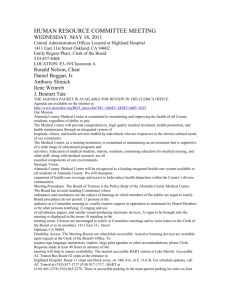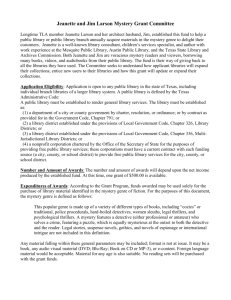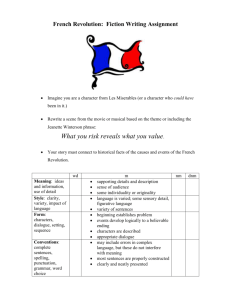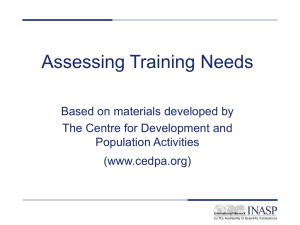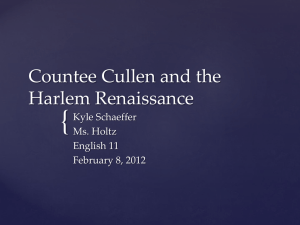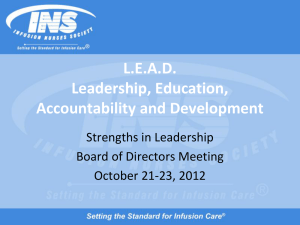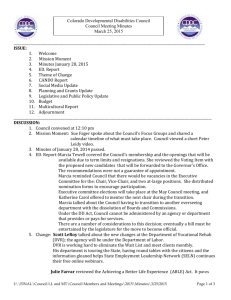Case Studies: Diversity in the Classroom
advertisement
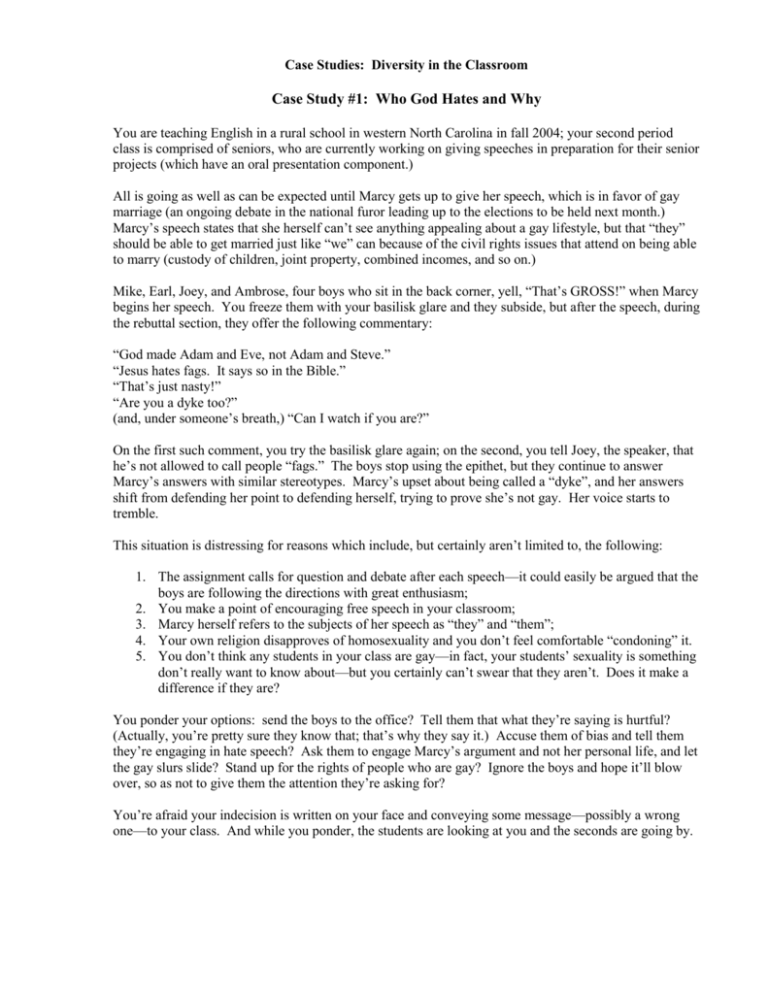
Case Studies: Diversity in the Classroom Case Study #1: Who God Hates and Why You are teaching English in a rural school in western North Carolina in fall 2004; your second period class is comprised of seniors, who are currently working on giving speeches in preparation for their senior projects (which have an oral presentation component.) All is going as well as can be expected until Marcy gets up to give her speech, which is in favor of gay marriage (an ongoing debate in the national furor leading up to the elections to be held next month.) Marcy’s speech states that she herself can’t see anything appealing about a gay lifestyle, but that “they” should be able to get married just like “we” can because of the civil rights issues that attend on being able to marry (custody of children, joint property, combined incomes, and so on.) Mike, Earl, Joey, and Ambrose, four boys who sit in the back corner, yell, “That’s GROSS!” when Marcy begins her speech. You freeze them with your basilisk glare and they subside, but after the speech, during the rebuttal section, they offer the following commentary: “God made Adam and Eve, not Adam and Steve.” “Jesus hates fags. It says so in the Bible.” “That’s just nasty!” “Are you a dyke too?” (and, under someone’s breath,) “Can I watch if you are?” On the first such comment, you try the basilisk glare again; on the second, you tell Joey, the speaker, that he’s not allowed to call people “fags.” The boys stop using the epithet, but they continue to answer Marcy’s answers with similar stereotypes. Marcy’s upset about being called a “dyke”, and her answers shift from defending her point to defending herself, trying to prove she’s not gay. Her voice starts to tremble. This situation is distressing for reasons which include, but certainly aren’t limited to, the following: 1. The assignment calls for question and debate after each speech—it could easily be argued that the boys are following the directions with great enthusiasm; 2. You make a point of encouraging free speech in your classroom; 3. Marcy herself refers to the subjects of her speech as “they” and “them”; 4. Your own religion disapproves of homosexuality and you don’t feel comfortable “condoning” it. 5. You don’t think any students in your class are gay—in fact, your students’ sexuality is something don’t really want to know about—but you certainly can’t swear that they aren’t. Does it make a difference if they are? You ponder your options: send the boys to the office? Tell them that what they’re saying is hurtful? (Actually, you’re pretty sure they know that; that’s why they say it.) Accuse them of bias and tell them they’re engaging in hate speech? Ask them to engage Marcy’s argument and not her personal life, and let the gay slurs slide? Stand up for the rights of people who are gay? Ignore the boys and hope it’ll blow over, so as not to give them the attention they’re asking for? You’re afraid your indecision is written on your face and conveying some message—possibly a wrong one—to your class. And while you ponder, the students are looking at you and the seconds are going by. Case Study #2: Right Here in River City As a new teacher, you’ve got a great unit planned for your eleventh-grade class on the 1920’s, Modernism, The Great Gatsby, the Harlem Renaissance—it’s your favorite literary period, and you’re loaded for bear. It turns out, though, that all that great literature isn’t going as well as you expected. First, you give your students a web quest, with each group checking out a different aspect of between-the-wars literature. One strand leads a group to background information about the Harlem Renaissance; they have to visit the site, answer the guided questions, and present their findings to the class. On the day of the web quest, you notice that the Harlem Renaissance group is having problems. One student, Michael, is doing all the work; Joachim, next to him, wants to spring happily around from group to group and takes constant minding; and the third, Dawn, is sitting back sulking. She doesn’t say anything to you, but as discussion mounts and students seize the opportunity to “share” informally during group time, you overhear Linda ask her what her group’s studying. Dawn replies, “Black people!” and both she and Linda laugh like it’s the greatest joke in the world. Dawn goes on to say they’re “all poor” and she thinks this assignment is stupid. It’s a bit hard to do anything immediate about this because the class noise level is mounting, you’ve just dragged Joachim back to his seat again (you remind yourself to ask if you can check for an IEP on him, in case he suffers from ADD), and you need to get everyone on task again. However, when they come to present, the issue comes up again. The Harlem Renaissance presentation is erratic at best; Michael’s learned something, but neither Dawn nor Joachim seem to have. They’re convinced (or want you to think they’re convinced) that the Harlem Renaissance is about poor people in a ghetto. They seem to have missed the artistic and literary aspects of the movement. Not sure what to do about this, but very sure you don’t want the rest of the class to take home this impression, you undertake to fill in the gaps yourself. You explain about the artistic resurgence that took place in Harlem; you quote W.E.B. Du Bois. The kids aren’t impressed. You add that this was especially interesting because all this literary flowering was coming out of a tradition of plantation oppression, Jim Crow laws, lynching, unequal laws and education, and all the rest of it. They look unimpressed and uncomfortable. Deciding to take the bull by the horns, so to speak, you ask them what’s up with that. What’s bothering them about studying the Harlem Renaissance? (You look at Dawn meaningfully.) What’s so funny about studying “black people”? Your class, I should add, has no visible “black people” in it, if by that they mean African-Americans. There are about three “brown people”, that is, darkly complected students who might equally be Hispanic, Cherokee, deeply tanned “white” people, or none of the above. The rest look “white.” But your question unleashes a flood of answers. Lois says that “they” hate “us” anyway, so what’s the point of studying “them”? Tom says he’s tired of being made to “feel bad” about “black people” when he’s never “done anything” to “them.” Brad starts rambling about migrant workers in Henderson County and how “they” create trouble wherever “they” go, ride around in cars trying to “start something” and being “noisy.” The darker students in the class (and you don’t know yet what their ethnic heritage might be) aren’t saying much. Now, you knew your students came from a homogeneous rural environment, so it was all but given that you’d encounter some racism. But you’re surprised that it’s so widespread; you’re startled by the rationales which justify it; and you’re not sure what to do about it right now. Continue the discussion and try to defuse some of this? Shut it down right now? Tell them they’re racist pigdogs and they’re going to burn in hell? (Actually, you’re pretty sure that’s not the right answer.) What do you do? Formulate a strategy. Case Study # 3: Who’s the Victim? As the new teacher at Cherokee High, you’re excited about your position. The school has funds for you to embrace extracurricular activities; as something of an amateur historian, you know that the Cherokee nation has suffered a lot in the past from inadequate education and racial and cultural stereotyping, and you’re eager to make a difference. But as a young, white teacher, you soon begin to feel that maybe all’s not as great as it seemed to be. For one thing, your sophomores aren’t very well trained at all. They don’t seem to know material from the ninth grade SCoS (and even earlier). You have great activities to get discussion started, but they don’t seem to like discussion. In fact, everyone seems happiest when you simply lecture and “give notes” . . .notes which, unfortunately, they don’t actually take down. You don’t especially like lecturing; you want them to be involved and enjoy class; your mind goes uneasily to stereotypes you’ve heard about a culture of apathy, about the individual allocations fostering disinterest. On the second day, when you were giving an overview of the syllabus, John asked, “Do we have to read about white people in this class?” A bit taken aback, you said, “Yes, we’re going to read about everybody in this class.” John subsides, but he doesn’t look happy. As one of three “white” people in the class, you’re not sure you’re so happy either. You talk to your mentor, who tells you that the SCoS is “more of a guideline” in Cherokee; as a federal rather than a state school, Cherokee High does follow the SCoS, but it doesn’t legally have to. Technically, you can teach native American works in your tenth grade class. Aha, you think, and charge to the library to take out some Sherman Alexie; you find you really like the stories in The Lone Ranger and Tonto Fist-Fight in Heaven, and, to make everything even better, Cherokee has funds enough to allow you to copy some stories for every student. Only problem? The students don’t seem to like this material either. They don’t seem to hate it, but they don’t show an interest; they don’t seem pleased that they’re reading an Indian author; in fact, it’s not really clear that they even “get” the stories. Maybe Alexie’s combination of the postmodern and the ironic is too much for them, you think. But you’re not a native American literature specialist; British literature is actually your favorite. While you’re looking around for something else that might interest them, you go back to All Quiet on the Western Front, which has the benefit of being in the bookroom. They don’t seem very interested in that, either, even the ones whom you know play war games online. As the semester goes on, in fact, your students show signs of becoming masters of passive resistance; when you ask a question, they shrug or say softly, “I don’t know.” When you ask them to do something, they might do it slowly and incompletely; they might simply not do it. Sometimes you can get a little discussion started, but mostly it falls flat. Some of your students are actively hostile some of the time, but you don’t know if it’s because you’re making them work more than last year’s teacher, because you’re young and white, or because of something totally unrelated, like student troubles at home. You hate to be angry all the time, though when you are, sometimes it gets a reaction. More often, though, they seem pleased to have goaded you. You hate to be a martinet, but if you can’t get them to do some work, you think, you’ll never be able to help them in any way. These are bright kids; when they’re interested, they’re alert, they ask good questions, and once, when you overheard Sam telling a story to John in the cafeteria, he was incredibly articulate, expressive, and funny. Are you a victim of racism, you wonder? Are you in some way saying to them that you’re a racist? Are they perhaps victims of previous racism, either from white teachers, from Indian teachers, or both? What do you think’s really going on here, and how can you change it? Case #4: Suffering a Witch Although you’re licensed in 9-12 language arts, you wound up teaching middle school, not unlike many another secondary education major. Since the beginning of the school year, you’ve been a little concerned about Jeanette, a tall, blonde twelve-year-old in your seventh-grade class. Jeanette wears dark “Goth” clothing to school, although not to the extent that some students do, and she’s quiet and shy around her classmates and around you. She has a sweet smile, but you’ve rarely seen it. Her classmates generally tease her rather than talk to her, and she seems to have no close friends. When you confer with her mother, Marie, you tell her that Jeanette is doing C+/B- work, but that you’re sure she can do better. Marie comes off as a loving mother, if one with little time (as a single mom, she works a lot); she tells you that Jeanette likes to write poetry, play her flute, walk with her dog, and read her religious books. She gave Jeanette her favorite notebook for her birthday, the one with Justin Timberlake on the cover. You’re relieved to hear that Jeanette has some outlets, and that her mother seems to know what’s going on with her. In late October you come back into class from the hall to find a circle of other students around Jeanette’s desk, chanting “Jesus Loves You.” Jeanette, apparently not finding this reassuring, has her arms wrapped tightly about herself, her head down, and her hair hanging over her face. You ask loudly what’s going on, and the group scatters. You ask Jeanette if she’s okay; she nods and doesn’t say any more. A week later, you hear the chanting again; this time, the students are slower to break up, and one of them is holding a Bible. When you demand an explanation, Katie tells you that Jeanette’s a witch. You ask, “What?” and several kids say, “Yeah. Witch. Black magic.” You tell them not to be silly; there are no such things as witches, but there are such things as grammar tests, so they’d better get started on theirs and leave Jeanette alone. Later, you ask Jeanette if she wants to talk; she says she doesn’t and hurries out of the room. Over the next months, though, the taunting seems to escalate. Jeanette is alone more and more, and most students call her, “that witch girl” even when you reprove them. “But she is a witch,” Penny tells you earnestly. “She reads witch books. And she wears all black because she’s a witch.” You roll your eyes and tell Penny that Jeanette’s not a witch, she’s just dressing Goth; sometimes it’s hard to believe kids have such wild imaginations, or can be so intolerant based on them. At your next parent conference, you hope to see Marie and ask her what she knows about this, but Marie doesn’t make it in. You phone her at home, and after a few days she returns your call. You ask about Jeanette: whether Marie thinks she’s okay, why the kids would think she’s a witch. “Oh, she is a witch,” Marie agrees. You’re startled. Marie goes on, “That’s her religion: Wicca. They call it neo-paganism too. She asked for the books, and there didn’t seem to be any harm in them, so I got them.” You’re even more startled; you may have heard something about this on the news occasionally, or seen part of an episode of Charmed, but it’s largely off your radar. “Do you mean . . . she’s a Satanist?” you inquire. There’s a pause. “I don’t think so,” Marie says. “I read through some of the books, and they all talk about love and nature, and being part of everything. It’s a new religion. It doesn’t have anything to do with Satan. Jeanette says witches don’t believe in Satan anyway.” Stumped, and not wanting to mix church and state, you change the subject. “What about the kids making fun of her? Does Jeanette talk about it?” “I know she gets picked on,” Marie tells you. “And of course it bothers her. But I don’t think it’s any worse than a lot of kids get. Kids are mean. They just are. There’s not a lot you can do about it.” She has you on that one; Jeanette’s hearing a lot about Jesus, and about how bad witches are, but it’s hard to equate chants of “Jesus loves you” with the hazing that happens on the football team, the boy who got thrown down the stairs and broke his arm, or the young woman whom no one speaks to at all, for any reason. You thank Marie and hang up. You mean to look up “Wicca” on the internet, but it’s getting toward the end of the marking period and you never seem to get around to it. As the grading piles up, Jeanette has good days and bad days; her work isn’t looking so good, but it’s hard to spend a lot of time worrying about it because of all the students who are difficult in more noisy ways. There are thirty students in Jeanette’s class alone. In the middle of February, Jeanette misses school. The next day you read in the paper that she’s hanged herself from her bunk bed with a scarf. In her journal, which becomes largely public knowledge over the weeks following her death, she attributes her unhappiness to being persecuted about her religion by her classmates; she writes that she will always be alone and that no one will ever understand her. More than a hundred students attend her funeral, some leaving notes saying that they didn’t mean what they said, that they didn’t want her to die. You wonder what else you could have done to prevent it; more immediately, though, you wonder how to keep it from happening again. What were your options? Should you have pressed Jeannette to talk to you? How will you know it, the next time routine high-school unhappiness segues into something worse? And where’s the line between normal teasing and actual torment? Does it vary from one student to another? How will you know? What will you do? Case #5: Not the Bias You Expected As a second-year teacher at a school on the outskirts of Asheville, you expect to encounter issues with racial and cultural diversity; but you’re surprised to see that your first-period class of ninth-grade language arts appears to be all “white.” You know that you can’t necessarily assume everyone’s the same race by looking, but on the face of it, this is a very homogeneous class. You’re both disappointed—you felt well prepared with activities, readings, and posters which emphasize appreciation of diversity—and a little relieved: at least you won’t have to deal with students attacking each other with racial slurs, though you can still expect more abstract, casual forms of bigotry. As the semester progresses, though, you find that your suburban white kids actually have quite a lot of issues with not-so-sensational diversity. Some examples: there are four children who are significantly overweight for their ages, especially Jenny. The students don’t pay a lot of attention to her one way or another except for Mel, who always calls Jenny “Skinny,” clearly not as a term of affection (Mel is a master of youthful verbal irony.) Most students refer to Jenny as “the fat girl” and to the two other children as “the whales,” though apparently not with especial malice, and mostly not to you. Jenny cringes when she hears it, but she doesn’t let it stop her from voicing her opinions about anything and everything else as loudly as possible. In fact, the only thing you haven’t heard her talk about is her weight. You feel for Jenny, but you also wonder if she wouldn’t have an easier time if she weren’t so loud and obnoxious, or if she’d just try to lose a few pounds. No one seems to have physically hurt Jenny or the other heavy students, at least not recently; you don’t know if Jenny mostly doesn’t think about her weight, if her vocal outbursts are an attempt to compensate for her sufferings and show that she doesn’t really care, or what you ought to do about relatively mild, sporadic demonstrations of prejudice against weight from the other students. If you say something, are you making a big deal out of it? If you say nothing, are you contributing to the heavy children’s suffering? your students routinely use “retard” (the noun) and “retarded” (the adjective) to mean “stupid”, “uncool,” or “temporarily looking foolish.” You don’t like this; you like it even less because you have three students with learning disabilities, Mick, Andy, and Sonya. The class presumably knows about Andy’s disability because he takes his tests in a separate setting; you’re not sure if they know that Mick has a mild form of dysgraphia or that Sonya suffers from ADD. You also suspect there may be some stillundiagnosed disabilities among the other students, and when you have time, you’re pursuing efforts to get the students in question tested. Meanwhile, your students are astonished when you tell them you don’t want to hear these words; as with “fat,” they clearly think these are simply descriptive, if derogatory, words, and feel oppressed that you don’t want them to use them. Some students keep using them out of what appears to be resistance; some seem to simply forget, and look astonished all over again when you call them on their language. Whatever the reason, you’re not having much luck stamping out this language; you’re pretty sure your students with disabilities feel targeted (except for Sonya, who seldom stays in her seat, they’re very quiet and keep a low profile); you don’t want to spend the rest of your school year sending your class one by one to the office for saying, “You retard!” every time one of them drops a book or trips over a chair or “that’s retarded!” when they hear that there’s a test coming up. By the same token, the class has already learned that “gay” means stupid, uncool, and lame (itself an interesting shift from a descriptive word to a derogatory one.) The same thing happens: you tell them you don’t want to hear the word, they make some efforts not to speak it but forget or resist at least as often as they succeed; you aren’t sure how many of them really know what “gay” means; and you don’t want to get into it with their parents for “condoning” or “preaching” a gay lifestyle in your classroom. You wonder what to tell them and how to prevent this; you wonder how many of your students already know that they themselves are gay and are learning every time the word is used that no one respects them. In short, you may be off the hook on racial issues, which never seem to come up; but three of our culture’s favorite prejudices are alive and well among your fourteen-year-olds. What do you do?
